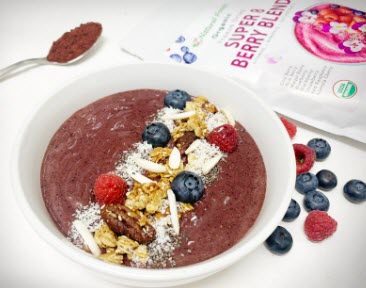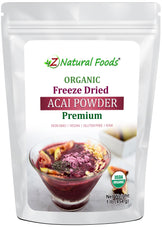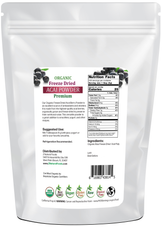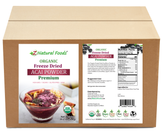Description
Description
In many cultures worldwide, berries are considered a staple in the human diet.
However, while some of these berries are regarded as common foods, they are often used as local medicines or tonic foods, depending on the culture.
Here are some examples:
- Goji berries are not just a staple in the Asian diet but also a major tonic food and part of the Traditional Chinese Medicine system. Goji is traditionally known in TCM to tonify all three treasures (Jing, Shen, Qi), Yin, and Yin blood, brightens the eyes, enters the liver, lung, and kidney meridians, and has a sweet flavor and a neutral, balancing temperature.
- Acai berries and Acerola Cherries are essential staples in the South American diet and are used in various applications for local remedies.
- Blueberries, Strawberries, and Raspberries are considered common foods in the American diet and are studied worldwide for their powerful nourishing qualities.
Modern research confirms the importance of adding a variety of foods with bright, vibrant colors that contain a wide range of potent polyphenolic compounds to support the repair process from the damage caused by stress, helping to create a more balanced internal environment.
Therefore, it should come as no surprise that these nutritional powerhouses that contain a wide array of unique compounds and are known for their deep, rich, and vibrant colors profoundly affect human health.
But, to understand the benefits of combining all of these nourishing berries fresh or as a freeze-dried powder, it is first essential to discuss the concept of synergy.
The primary principle behind synergy is understanding that the whole is greater than the sum of its simple parts. When applying this concept to foods like berries, it is essential to know that the potent compounds in various berries have a broader spectrum and nourishing effect than any individual compound within that mixture.
When eaten as a whole food matrix, no individual compound works alone. Therefore, it is reasonable to conclude that combining a wide variety of berries will provide more potent nourishment than consuming a standardized version of any individual berry.
Before we get into the primary purpose of consuming a wide array of berries, it is important to acknowledge that while a mixture of berries is a better choice, each berry does have its own unique attributes.
For example, Blueberries are a tremendous source of Anthocyanins (flavonoid water-soluble pigments that give fruits and vegetables their color). They account for about 60% of the total polyphenols in blueberries, yielding approximately 500 mg/100 grams, ranking them at #16 (behind some pretty impressive contenders) for the food richest in polyphenols. Other predominant bioactive components found in blueberries are pterostilbene, resveratrol, and the flavonols kaempferol, quercetin, and myricetin.
Blueberries have impressive preliminary and human studies showing the broad spectrum of nourishing benefits on the brain and nervous system.
One of the blueberries' primary mechanisms of action is their direct effect on improving vascular and cerebral blood flow. In simple terms, cerebral blood flow measures the blood delivery rate in the arteries to a capillary bed in the brain tissue. While researchers found that up to six cups of blueberries daily improved memory in just 12 weeks, this was determined to be an unrealistic dose for most people to stay consistent with. Therefore, it was determined that just one cup of blueberries daily for older adults showed some improvement in long-term memory.
A survey of the antioxidant capacity and phenolic composition of blueberries, blackberries, and strawberries concluded that blueberries have exceptionally high levels of anthocyanins and proanthocyanidins.
A study in neural regeneration research conducted on young and old participants who consumed blueberries daily showed an increase in blood flow to key brain areas and improvements in memory and attention.
While each berry possesses unique qualities and compounds for various health purposes, they all fall under (at some level) these four general categories of plant compounds:
1) Polyphenols
Polyphenols are a term used to describe a general category of compounds found in a broad spectrum of fruits, vegetables, and tea that work as “reducing agents” along with other compounds known as antioxidants to support a healthy inflammation response and the body's ability to protect and repair damaged tissue caused by oxidative stress. While over 8,000 polyphenols have been identified, some of the most common are flavonoids, flavonols, and anthocyanins. The importance of discussing these various compounds allows you to more clearly understand the wide range and complexity of nourishment you are getting from these powerful foods.
2) Flavonoids
Flavonoids are a group of water-soluble polyphenolic secondary metabolites found in plants thought to provide health benefits through cell signaling (The process when a cell responds to a substance outside the cell through signaling molecules found on the surface of that cell) and antioxidant effects. Secondary metabolites are substances manufactured by plants that make them compete in their environment, exerting a wide range of effects on the plant itself and the surrounding living organisms, including flowing, fruit setting, signal deciduous behavior, and acting as antimicrobials. Over 50,000 secondary metabolites have been discovered, and many modern medicines rely on them for their mechanism of action. There are six major subclasses of flavonoids: Anthocyanidins, flavan-3-ols, flavonols, flavanones, flavones, and isoflavones. These account for around 60% of all polyphenols.
3) Flavonols
Flavonols are polyphenols belonging to the flavonoid family with a ketone group studied for their wide range of biological activities (antioxidant, antimicrobial, hepatoprotective, modulating inflammation, and vasodilation). They primarily accumulate in the outer tissues (skin and leaves) of fruits and vegetables, are the building blocks of proanthocyanidins (compounds that are attributed to the colors of fruits and vegetables), and are most widespread in the human diet.
4) Anthocyanins
Anthocyanins are a part of the flavonoid family of polyphenolic compounds. They represent the pigments that exhibit the bright red, purple, and blue colors found in fruits and vegetables. The six most common are cyanidins, delphinidins, malvidins, peonidins, petunidins, and pelargonidins.
The above four general categories of plant compounds are the primary reason we should consume a wide array of berries in our diet.
These various classes of compounds are what create the powerful healing aspects that berries provide.
Powdered vs. Fresh: Are There Benefits of Consuming a Berry Mix Powder?
The idea that we can’t replace fresh food with a powder to nourish our body is simply untrue. As a matter of fact, there are many significant advantages to using powders, especially with berries.
While there are many natural ways to dry foods and preserve their nutritional qualities, including low temperature, shade, air, sun, and freeze-drying, the quality of the raw materials predominantly determines the final product.
Ultimately, preserving the incredibly nourishing qualities found in berries is obtained best through the method of freeze-drying.
There are three primary advantages to using a freeze-drying method.
- Freeze drying creates the closest end product when presenting a whole food complex.
- Freeze drying a food presents closest to the smell, taste, and texture of the fresh version of a food.
- Freeze-dried foods allow you to customize your needs when creating a product, and freeze-dried berries can be left whole, chopped, or milled into a powder. All of which will still offer the nutritional value that comes from the fresh version.
Because berries perish quicker than most foods, this method preserves their structure and integrity and significantly extends their shelf life. The shelf life of any food or product is directly linked to its moisture content.
A freeze-dried product has an average of only 3% or less moisture content. So, freeze drying allows for greater versatility of the end product due to more accessible storage options and blending capability and supports the natural flavor profile of the fresh food version.
In conclusion, modern technology has allowed us to take foods that perish quickly and create a highly versatile food product that provides the same nourishing qualities with an extended shelf life.
Berries' powerful qualities have been backed by quality science, and they are a delicious way to get great nutrition. So, yes, mixed berry powders have great benefits and should be a part of your daily food consumption.
Recipe: Super Berry Bowl Smoothie (with Coconut and Chia Seeds)
Here’s a delicious and easy-to-make smoothie recipe using our Organic Freeze-Dried Super 8 Berry Blend.
Not only is this possibly the healthiest berry smoothie you’ll ever enjoy, but its perfect for a healthy breakfast to fuel your entire day!
It’s also great for lunch, dinner, a snack or anywhere in between.
That’s because this Super Berry Bowl is made with our freeze dried berry mix featuring eight of the most nutrient-rich berries on earth.
Naturally sweet, sour and delightfully tart
The berries in the Super 8 Berry blend include: acai berry, goji berry, maqui berry, blueberry, black berry, strawberry, red raspberry and acerola cherry.
Here's what you need and how to make this fantastic berry bowl:
- Bananas: Ideally frozen bananas since they are naturally super sweet and creamy.
- Almond Milk: You need some kind of liquid to get things moving along while blending. Almond milk can be added for extra protein boost (feel free to add any of your favorite milk).
- Honey: To enhance sweetness. If you are satisfied with the banana's sweetness, no need to add honey.
- Fresh berries can be added to the recipe to increase thickness and texture.
Ingredients for your smoothie
- 4 Tbsp of Organic Super 8 Berry Blend
- 1 Tsp of Honey
- ½ Cup of Almond Milk (or any milk)
- 2 Frozen Bananas
Delicious Toppings
- Organic Black Chia Seeds
- Organic Almonds (Chopped)
- Organic Shredded Coconut
- Fresh Fruits (of your choice)
Directions:
- In a high speed blender, add frozen bananas, almond milk, honey and Super 8 Berry Blend.
- Start blending on low speed till all frozen bananas are broken up.
- Continue blending at high speed until smooth paste.
- Pour smoothie into a bowl and top with all your favorite toppings.
- Best enjoyed immediately.
For information about our Organic, Freeze Dried Super 8 Berry Blend, go here:













































































































